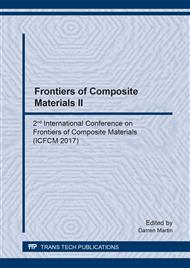[1]
A. M. Youssef, S. A. Mohammed, M. S. Abdel-Aziz, M. E. Abdel-Aziz, G. Turky and S. Kamel: Carbohydrate Polymer Vol. 147 (2016), pp.333-43.
DOI: 10.1016/j.carbpol.2016.03.085
Google Scholar
[2]
J. Li, X. Qian, L. Wang and X. An: BioResources Vol. 5 (2010), pp.712-726.
Google Scholar
[3]
X. Qian, J. Shen, G. Yu and X. An:, BioResources Vol. 5 (2010), pp.899-907.
Google Scholar
[4]
Y. Zhou, C. Ding, X. Qian and X. An: Carbohydrate Polymer Vol. 115 (2015), pp.670-676.
Google Scholar
[5]
M. Idrees, A. Razaq, A. Islam, S. Yasmeen, K. Sultana, M. H. Asif, M. Nadeem: Synthetic Metals Vol. 232 (2017), pp.138-143.
DOI: 10.1016/j.synthmet.2017.08.009
Google Scholar
[6]
S. Bhadra, D. Khastgir, N. Singha and J. H. Lee: Progress in Polymer Science Vol. 34 (2009), pp.783-810.
DOI: 10.1016/j.progpolymsci.2009.04.003
Google Scholar
[7]
J. Huang and R.B. Kaner: American Chemical Society Vol. 126 (2004), pp.851-855.
Google Scholar
[8]
J. Stejskal and R. G. Gilbert: Pure Applied Chemistry Vol. 74 (2002), pp.857-67.
Google Scholar
[9]
M. Trchová and J. Stejskal: Pure Applied Chemistry Vol. 83 (2011), pp.1803-1817.
Google Scholar
[10]
X. Yan., Z. Tai, J. Chen and Q. Xue: Nanoscale Vol. 3 (2011), pp.212-216.
Google Scholar
[11]
T. Niesen and M. De Guire: Solid State Ionics Vol. 151 (2002), 61-8.
Google Scholar
[12]
H. Pathan and C. Lokhande: Bulletin of Materials Science Vol. 27 (2004), 2, pp.85-111.
Google Scholar
[13]
J. K. Pamatmat, A. V. Gillado and M. U. Herrera: IOP Conference Series: Materials Science and Engineering Vol. 201 (2017), 012041.
Google Scholar
[14]
N. F. Mott and E.A. Davis: Electronic Processes Non-Crystalline Materials (Oxford University Press, Oxford, 1979).
Google Scholar
[15]
M. P. J. van Staveren, H. B. Brom, and L. J.de Jongh: Phys. Reports Vol. 208 (1991), pp.1-96.
Google Scholar
[16]
E.Ahlatcıoğlu Özerol, B.F. Şenkal and M.Okutan: Microelectronic Engineering Vol. 146 (2015), p.76–80.
DOI: 10.1016/j.mee.2015.03.062
Google Scholar
[17]
D. L. Sidebottom: Physical Review Letters Vol. 82 (1999), pp.3653-3656.
Google Scholar
[18]
J. Lloyd-Hughes and T. I. Jeon: Journal of Infrared, Millimeter, and THz Waves Vol. 33 (2012), pp.871-925.
Google Scholar
[19]
A. N. Papathanassiou: Journal of Physics D: Applied Physics Vol. 35 (2002) L88.
Google Scholar
[20]
B. Rolling, A. Happe, K. Funke, and M. D. Ingram: Physical Review Letters Vol. 78 (1997), p.2160.
Google Scholar
[21]
K.-M. Jäger, D. H. McQueen, I. A. Tchmutin, N. G. Ryvkina and M. Klüppel: Journal of Physics D: Applied Physics Vol. 30, No. 17 (2001).
Google Scholar


